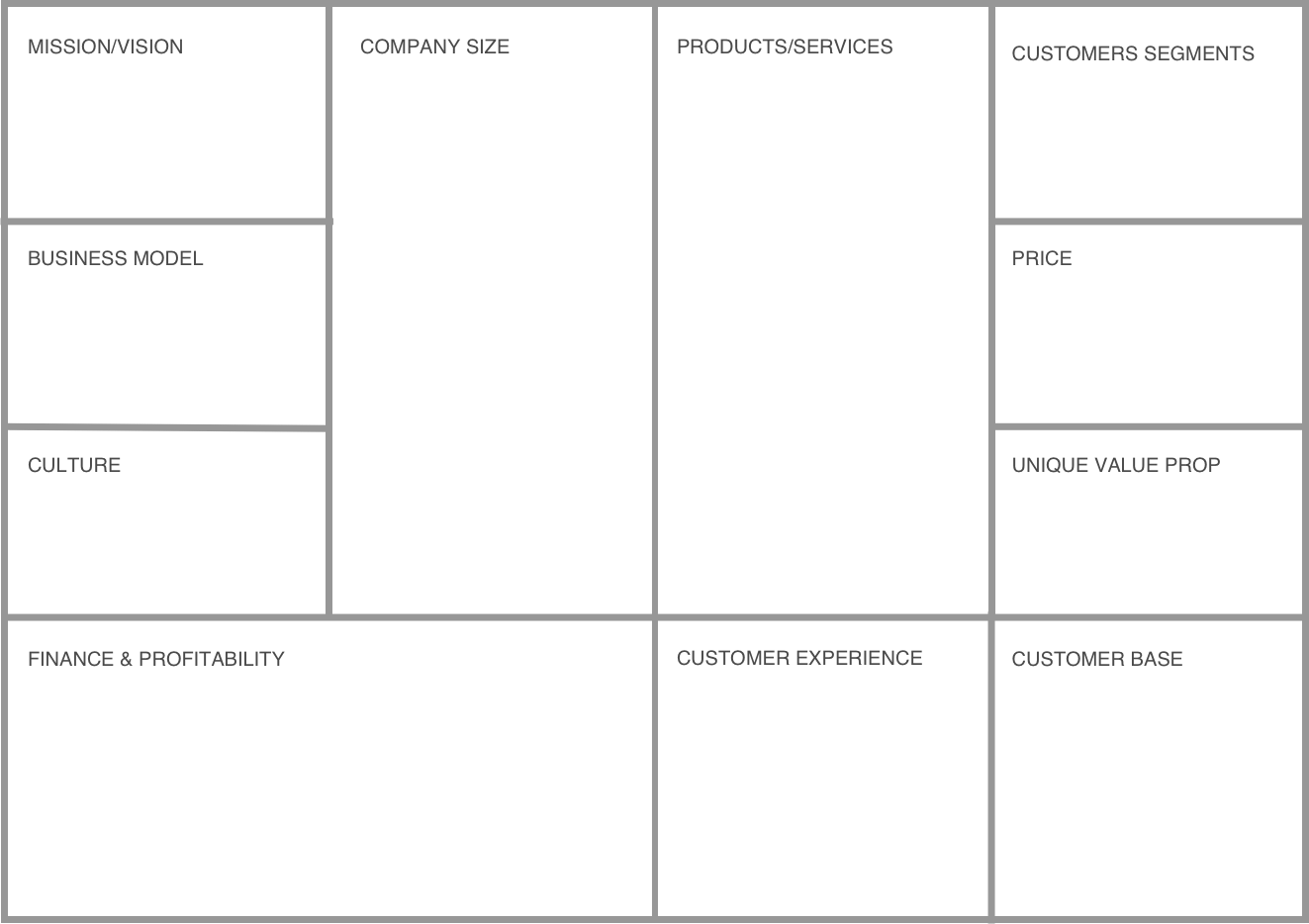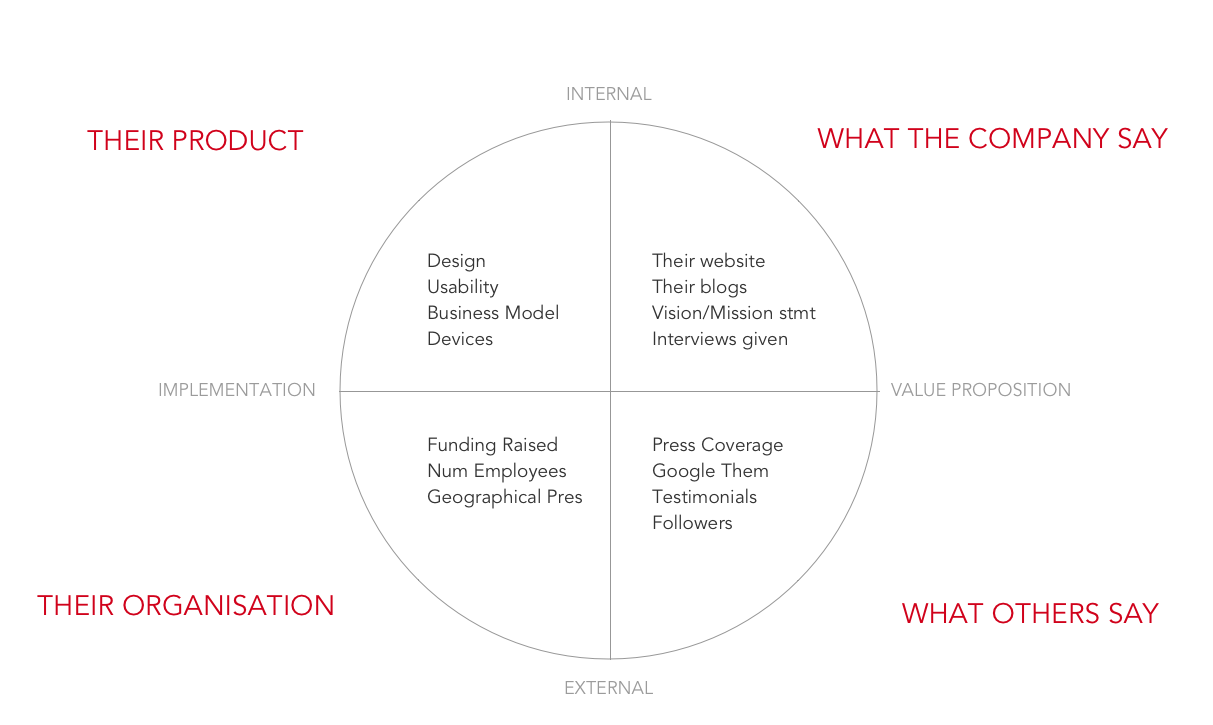When we talk about the term "product" in product management, we typically refer to digital products (such as websites, mobile apps, and software). When we want to analyze the competition, we have to research both the company itself as well as its (digital) product and services. In order to make sure that we consider all of the relevant areas of a competitor's company and products, we use a competitive analysis canvas as a framework to evaluate each competitor.
What is a competitive analysis canvas?
A competitive analysis canvas is a one-page chart that you can fill in to generate a high-level analysis of a particular competitor.
The canvas is divided into eleven sections, each of which asks an important question:
What is the mission/vision statement of the competitor?
What is their business model/how do they charge customers?
What is the size of the company (employees, geographical footprint, market share)?
What is the financial situation of the company (revenues, profits, funding raised)?
What are the major products/services/product features?
Which customer segments do they target?
How do they price their products/services?
What is their unique value proposition (what is unique about what they do)?
What is the company culture?
What is the customer experience?
How many customers/users do they have?

Choosing a list of competitors
Before you can fill in a competitive analysis canvas, you must make a list of companies that are potential competitors.
Determine which "job" the customer is trying to do.
Make a list of any company that providers a product or service that can be used to do this job.
Choose the top 3-4 companies and complete a Competitive Analysis Canvas for each.
Making a list of companies is easy. Start with a Google search using keywords that a typical customer would type, and this will show a page of companies that are likely competitors. You can then visit their websites, read more about them, and determine if they should be on your list or not.
Where to do research
When you conduct competitor analysis for a digital product, consider the following:
What the company says about themselves (their website, their blog posts, annual report)
What others say about them (press coverage, social media, online reviews, testimonials)
Which facts you can find about their organization (funds raised, number of employees, geographical presence)
Which products/services they offer (try them to assess features, design, and usability)

Canvas sections
Mission/vision - A mission statement declares an organization's purpose, or why it exists. That often includes a general description of the organization, its function, and its objectives. A vision statement describes where the company aspires to be in the future. Reading the mission and vision statement are excellent ways to begin understanding a competitor company.
Often this information is visible on the company website in the "about us" section or available in the company's publicly available annual report. The mission of Sweetgreen, for example is "to inspire healthier communities by connecting people to real food."
It can sometimes be hard to find a company's mission and vision statement. In this case, take a sentence from their homepage that seems to summarize their mission.
Products/services - One of the first things you should do when evaluating a competitor is to visit their website and use their product. Make sure to try everything on desktop and mobile. If they have a free and paid version, consider trying both to see the difference. If they have several products, you may want to try them all.
Business model: It is important to understand how a company makes money. For example, the New York Times charges customers a monthly subscription fee, whereas the Huffington Post offers free articles and makes money from advertising. Groupon and eBay are examples of multi-sided platforms that connect buyers and sellers. Both take a commission fee from the seller. Here is a nice list of potential business models.
Company size: There are a number of measures for company size:
Market share
Revenues
Number of employees
Geographical footprint (how many countries in which this company is active)
A company's annual report can be a good source of information. It can often be found in the "investor relations" section of the websites of larger companies (e.g., Apple Investor Relations). As company leaders mention this kind of information in interviews, consider perusing press releases, media articles, and video interviews.
Finance & profitability: Revenue and profit are the most important financial metrics.
Revenue and profit figures are often found in the annual report. Companies like Apple will break down their revenues and profits by product (iPhone, iPad, Mac, and iWatch). A start-up will be more concerned with growth than profits.
Smaller companies may not put their annual return on their website but will have a listing on their country's annual company register. You can find a list of national company registers here for future reference.
How much finance they have available (how much funding they have raised and when) is a more relevant metric. Check Crunchbase and AngelList to see if you can see their funding history. Note that this information is not always available, but it is very interesting information if you can find it.
Customer segments: When creating a product, the product manager's goal is to find a problem and a set of customers who care about a solution to that problem. A customer segment is a set of customers who display certain characteristics (buying choices, preferences, age, nationality). For example, Ferrari cars are typically sold to wealthy customers who own more than one car. A great question to ask is, "Which factors influence customers to buy or to not buy?" Those factors are the most important to consider. Note that a company's homepage will have a message targeted to its potential customers, and reading it will often tell you who these target customers are (see Concur home page). The pricing page can also tell you who the target customers are. Quickbooks, the accounting software for small businesses, has monthly pricing of $5-$35 which indicates that their target customers are not large corporations.
Price: Pricing is often the easiest thing to find on consumer-based sites but can be harder to find for B2B (business-to-business) companies and products. Price may be a one time payment, a monthly subscription, or use-based. Companies often have multiple products, which may mean multiple pricing options.
Culture: There is a famous phrase that says "culture eats strategy for lunch," which roughly means that the company culture is more important than the strategy that a company has. The company may talk about their culture on their website, or it may be something mentioned in interviews or news articles. It's OK to leave this blank if you can't find any information about the company culture (or make an educated guess).
Customer base: How many users does the company have, and how many are paying customers? A company like Dropbox will have many users who utilize their free service and a percentage that pay for additional storage. User growth is also very important. A company with a small number of users/customers with a very high rate of growth could be considered equally important as a competitor with many customers but small/negative growth.
Customer experience: Does the competitor try to give the lowest price (Ryanair), the best possible service (Nordstrom), or a mix of reasonable price and reasonable service? Are customer requests responded to immediately or days/weeks later? Is it hard to find contact details on the website? Customer experience can also include the stylish box that an iPhone comes in or a direct email from the CEO to welcome you to the service.
Unique value proposition: What is unique about this company's offering to its customers? Is there anything that this company does that no one else can do? It could be a specific feature, a large community of users (Quora) or an algorithm (Tinder's matching algorithm). It could also be a strong brand in the case of Apple or Coca-Cola. What would be very difficult for another company to copy from this competitor?
Tips on completing a canvas
If you wanted to analyze four competitors, then you would fill in four canvases.
Aim to put around 3-4 bullet points for each section. The idea behind a canvas is to get a one-page representation, so you can't fit that many words on any one given canvas. Individual words or phrases work better than short sentences.
You can't fit everything on one page. Try to capture the main points of the competitor rather than worrying about squeezing everything in.
If you cannot find any information for one box in the canvas, leave it blank.
Some of the information you find might be a year or two old. Just use that information on the canvas. Your goal is to get an overall, high-level feel for the competitor so use the most current information you find.
Let's recap!
Competitive analysis starts with identifying competitors, and not just direct competitors.
Use a variety of resources to research:
what the company says about themselves ,
what others say about them,
the facts about their organization,
and the products/services they offer.
Completing a competitive analysis canvas will give you a one-page, high-level view of a competitor that you will be able to easily compare with canvases for other competitors.
